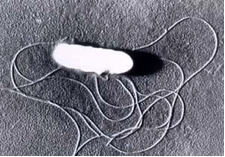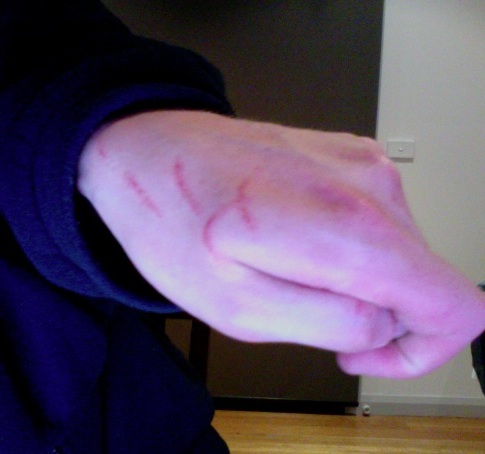In order for the immune system to respond to microbes like viruses or bacteria, and not to our own tissues, it needs to recognise them as foreign. How does our immune system do this, and what are the consequences?
Throughout the body are immune surveillance cells that are constantly on the lookout for invading microorganisms. In order to discuss the early immune response to a microbe I will first introduce you to one of these cells, the macrophage.

The cell in the middle is a monocyte. It becomes a macrophage when it matures, leaves the blood and treks to the site of inflammation. The ring-like cells are red blood cells and the little splodges are platelets.
Macrophages are a kind of white blood cell found throughout the body, in slightly different forms depending on the kind of tissue they’re in. As the name ‘macrophage’ (literally ‘big eater’) suggests, they are experts at gobbling up microbes. But what tells the macrophage to eat the microbe? How does the macrophage recognise it as foreign?
The key is in recognising molecules commonly made by microorganisms, but not people. These are often structural, or essential for the microbe to survive or cause disease. Bits of bacterial cell wall provide structural support to the cell and are often essential for bacterial survival, while flagella (whip-like ‘tails’ used for movement, below) are not essential to survive, but are often critical for setting up a successful infection. Concentrated samples of either of these are enough to induce a strong immune response, even without the rest of the microbe present.

Flagella on a bacterial cell. Flagella are long filaments that spin. Bacteria use them to move around, and they are often critical for the bacterium to set up an infection.
It’s not only completely foreign molecules that are recognised, but also familiar molecules organised in a foreign way. For example, the DNA of bacterial genomes may chemically resemble that produced by humans, but may encode combinations of bases uncommon in humans. Another example is RNA. Our cells use single strands of RNA to ‘read off’ the code in our DNA, while a lot of viruses use double-stranded RNA. This double stranded form can trigger an immune response, while our own single-stranded type does not. There are a wide range of molecular patterns that differentiate foreign microbes from our own cells and tissues.
These molecular patterns are the ‘danger signals’ that let the macrophage know it has found something foreign. You may remember this video from the last post:
[youtube=http://www.youtube.com/watch?v=a1xPpsxvhVA]
(Om nom nom)
In this case the bacterial sugar ‘mannose’ is the danger signal, which activates the macrophage, telling it to eat and destroy the bacterium.
The sensor on the immune cell that recognises the danger signal is called the pattern recognition receptor (PRR). In the example above mannose is the danger signal and the mannose receptor is the PRR. Not all pattern recognition receptors are expressed on the cell surface, because not all microbes turn up there. Many different PRRs are expressed in many places throughout the cell. For example, viruses replicate inside our cells, so that’s where we can find lots of receptors for double-stranded RNA and other viral products. As you can see, even the location in or on the cell where a PRR is expressed is fine-tuned for the kind of microbe it will recognise.
Recognising a wide array of molecules and looking for them inside and outside cells acts like a broad net, ensuring that potentially any infection can be recognised by our immune system.
So now our macrophage has found a microbe and recognised what it is, and hopefully destroyed it. What if there are more? He alone may not be able to deal with all of the invaders, and so calls for backup, bringing other white blood cells to the area. The way he does this is by triggering inflammation.
Sure, we all know inflammation, that annoying reaction you get around a wound when you accidentally cut your finger while chopping veggies. It is triggered by immune cells that recognise a potential infection, to call for other immune cells. It’s also triggered by tissue damage, that way if you do get a cut you will have some white blood cells there, ready to fight any microbes that try and enter through the wound.

inflammation around some cat scratches. Note that the areas around the scratch marks have become red and slightly raised.
There are five key signs which tend to accompany inflammation – heat, pain, redness, swelling and loss of function – but why are they occurring? How does a bit of bacterial cell wall lead to these symptoms, and how does it help bring immune cells to the area?
Receiving the danger signal has not only made our macrophage much better at eating and destroying microbes, but also caused him to produce pro-inflammatory chemical messengers. These molecules diffuse through the tissue and trigger changes in the nearby blood vessels. The vessels dilate (expand) and the cells that line them change shape slightly, opening up small gaps between them. They also start to express more ‘adhesion molecules’, which are kind of like Velcro to white blood cells. The normal (non-inflamed) levels of these molecules mean that white blood cells which bump into the vessel walls during circulation will stick and roll along the edges for a while, but can still dislodge.
During inflammation more and stronger-binding adhesion molecules are produced which mean that some cells will actually stick so strongly that they stop there. These cells then creep between the gaps and out into the tissue. Once out of the blood stream the newly recruited white blood cell can follow the trail of chemical messengers to the site of infection, and help out our macrophage. This is a video of the entire process occurring in a mouse, beginning with an explanatory cartoon.
[youtube=http://www.youtube.com/watch?v=WEGGMaRX8f0]
The dilation of the blood vessel also allows for some of the smaller soluble components of blood to leak into inflamed tissue. Some of these molecules bind microbes, attracting macrophages to them, and making them easier to gobble up, while others are capable of directly puncturing the cell wall, killing the microbial invader.
[youtube=http://www.youtube.com/watch?v=enIqgxml8nc]
It is this increase in the permeability of the blood vessels that allows blood components to flow out into the tissue, causing the macroscopic signs we recognise as inflammation: blood is at core body temperature, so the tissue its components leak into will get warmer, while the introduction of fluid causes swelling. These symptoms may be irritating, but they also allow the immune system to recruit white blood cells to the site of an infection, which is critical to our body’s defences against microbes.
Summary:
The immune system recognises microbes by the presence of molecular ‘danger signals’ that activate its cells. The immune cells that are activated this way can then tell the cells lining nearby blood vessels to change, helping bring while blood cells in from the blood stream. We recognise this on the macroscopic level as inflammation.
Next time I will discuss the later, more specific immune response mediated by the adaptive immune system, and how it produces the phenomenon known as ‘immunological memory’ in which the body is better able to fight of previously encountered microbes.

You might like these videos also:
http://www.wehi.edu.au/education/wehitv/the_immune_system/
Definitely. I love the WEHI guys, really respect their efforts to educate the public.
stop annoying your cat! especially for the sake of science! :P
I wouldn’t mind to much if it had been my cat…. and if the scratches weren’t still visible over a month later…
well that’s what you get for annoying the kitty, those remaining scratches are a reminder that ‘I must not annoy the cat’- ala Dorlores Umbridge.
I know this is a really old post but I hope you don’t mind the question – I’m wondering about the difference between the sort of inflammation you have there with the cat scratch and the sort of inflammation caused by an allergy. I have dermatographism for example, so if I scratch a fingernail lightly over my skin I’ll get raised welts – these have heat, redness, and swelling but more itch than pain … what’s different?
Hey, I didn’t see this, sorry! I’ll have a read on dermatographism and try and have an explanation here in a couple of days (sorry it couldn’t be sooner as I’ll be travelling… Not that a few days on top of the three weeks already waited is all that much… Again, sorry about that).